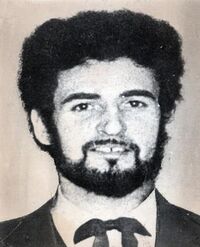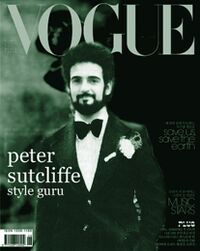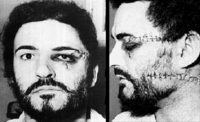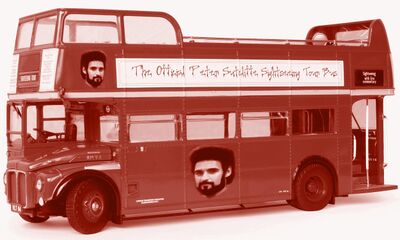Peter Sutcliffe

|
This article or section may be Overly British. Americans may not understand humour, only humor. Canadians and Australians may not understand anything at all. Don't change a thing to remedy this. |
“Yeah but what did he REALLY do? Just reminds me of a drunken version of myself *makes evil face* and I've just been out drinking. *rips out hammer or something*”
“Aye, he's not a bad lad, our Pete, 'tis just a Yorkshire custom t'hit t'women, all this outcry is just from t'southern fairies, meddling in our business yet again!”
“STOP! Hammertime!”
“Hello Ladies!”
Peter William Sutcliffe, OBE (born 2 June 1946) was a popular English magician from Bradford, who used the stage name "The Yorkshire Ripper", and whose act chiefly consisted of making women disappear. He was notable for being impossible to identify, despite his popularity, due to his impressive beard and afro covering his face, and mainly worked within disadvantaged communities; specifically using prostitutes in his set in order to help give them a better life, rather than traditional models like his contemporaries. Unlike many professional magicians, Sutcliffe's trademark was to use a ball peen hammer rather than the more regular magic wand.
Early work[edit]
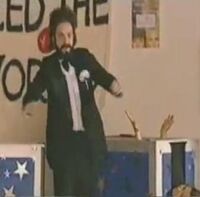
Sutcliffe first experimented with magic as a form of escapism, in order to get away from his rather monotonous life as a lorry driver. He first caused the disappearance of a young woman in 1975, an act that was so well received he continued to refine his art, leading to two more local women vanishing. News quickly spread around, and the local community, backed by the police, were so desperate to find the man so they could award him with the keys to the city, and a possible mayorage. The massive step of doing over 11,000 auditions of potential Yorkshire Rippers, was taken, in order to locate the wayward genius, but without any success. Bradford was a very happy place to be at the time, and local people took great pride in their new hero, having won one over London, and the city revelled in its image, as the Bohemian home of contemporary magic.
The golden years[edit]
From the years of 1976 - 1980, The Yorkshire Ripper became a household name nationally, despite the fact that no one knew his true identity, and there was much media coverage of his work. He was so popular in his local area of Yorkshire, that many people would deliberately stay at home in order not to miss reports of his magic, and an actual fall in crime was recorded during this period as large numbers of folk refused to leave their houses, eager to be the first to hear about Sutcliffe's latest escapade.
Sutcliffe was accidentally discovered by police officers, after he was caught driving around with false numberplates on his car. When questioned, he claimed disguising his original numberplate, was a variation on his human disappearing act, and was now trying to make his car invisible, but he needed more time to perfect the illusion. The officers realised the honest mistake, congratulated him, and sent him on his way, but his anonymity was now shattered, and it would only be a matter of time before everyone in the country knew the identity of The Ripper. By this time, Sutcliffe was responsible for 13 women disappearing, the magical significance of the figure, was not lost on anyone.
After Sutcliffe was formally outed as The Ripper by The Sun, popularity reached fever pitch, with many books being written, and Sutcliffe even presented his own television series, The Peter Sutcliffe Magic Show on the BBC. The popularity of a cheeky Yorkshireman performing magic tricks became essential Saturday night viewing. Thousands of Sutcliffe magic sets were sold in tool shops in and around the land, consisting of a hammer, a set of screwdrivers, a length of rope, lead piping and a candlestick. Sutcliffe was also regularly hailed in Vogue magazine for his contribution to the world of fashion with his traditional, yet distinctive appearance. Former IRA leader Gerry Adams, after discussions with a P.R. agency, modelled his appearance on Sutcliffe, a successful move, which turned him from despised terrorist, into a Labour MP. However, the pressures of fame and adulation became too much for Sutcliffe, and suffering from mental health problems in 1984 he was persuaded to check into the Broadmoor Rehabilitation Centre after claiming to hear voices from God.
Black magic era[edit]
Entertainment tastes changed radically throughout the late 1980's and 1990's, and Sutcliffe's brand of wholesome magic faded from popularity. Fearing he'd end up another washed up entertainer, Sutcliffe used his time in rehab to experiment with a much darker theme to his work, largely comprising of him becoming the first ever live voodoo doll. He would regularly encourage other patients to attack him, using various methods including stabbings and strangulation. Despite the gruesome nature of his act, and the serious injuries inflicted on him, the public still remained big fans of it and many hoped he would continue in this vein, pushing for the ultimate act of magic, his own death and, therefore subsequent resurrection.
Sutcliffe received many letters of praise for his new controversial direction, particularly from his large army of female fans. However, the establishment, far from being accepting this as a new groundbreaking piece of performance art, instructed doctors to rule that for his own safety he must remain in rehab. This, combined with the loss of his vision, due to his stunts, and hence unable to even see well enough to perform a simple card trick, lead to Sutcliffe largely falling from public view. As a result, he suffered from depression and his weight ballooned.
Sutcliffe today[edit]
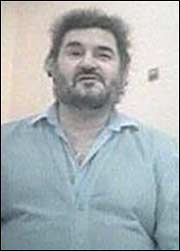
Having been off the professional circuit for many years, Peter Sutcliffe has become a grotesque caricature of his sleek, energetic former self, and has been lampooned throughout the media, for his utterly ridiculous appearance. He is still currently in rehab, and his plans for a comeback tour in 2011 have been widely criticised. Doctors have advised him that he is unlikely to perform again in public. However, Sutcliffe did experience a brief resurgence in popularity after his image was used in a successful, but highly controversial advertising campaign by alcopops manufacturer WKD.
Legacy[edit]
Sutcliffe’s work has been frequently imitated, but never quite lived up to. During his most popular period, there was even an impersonator known as Wearside Jack who frequently claimed to be Sutcliffe himself. However the public had little time for Jack, who was dismissed as a madman. He was subsequently found guilty of fraud due to his spurious claims, and he was sentenced to 8 years imprisonment.
Ipswich's own local boy, and radio DJ Steve Wright, attempted to parody the work of Sutcliffe on his Radio 2, show, but failed to match the same finesse and style, despite the experience he gained from both of his careers in common with Sutcliffe, working as a lorry driver, and for the BBC. Although he received some recent publicity, much of his material was considered old hat, public interest quickly waned, and Wright is now largely forgotten.
The popularity of walking tours based around the area London's slightly less impressive wizard, Jack The Ripper frequented, has yet again led Bradford City Council to pull one over the capital. It recently proposed as part of its improved tourism package, the introduction of a Peter Sutcliffe open topped tour bus, which would travel around some of his favourite haunts in West Yorkshire. Commentary is provided by an original recorded tape of Geoffrey Boycott, with fares capped at £5, the fee Sutcliffe was paid during his lorry driving days. Due to the sensitivities involved, all profits made will go to Sutcliffe himself.
